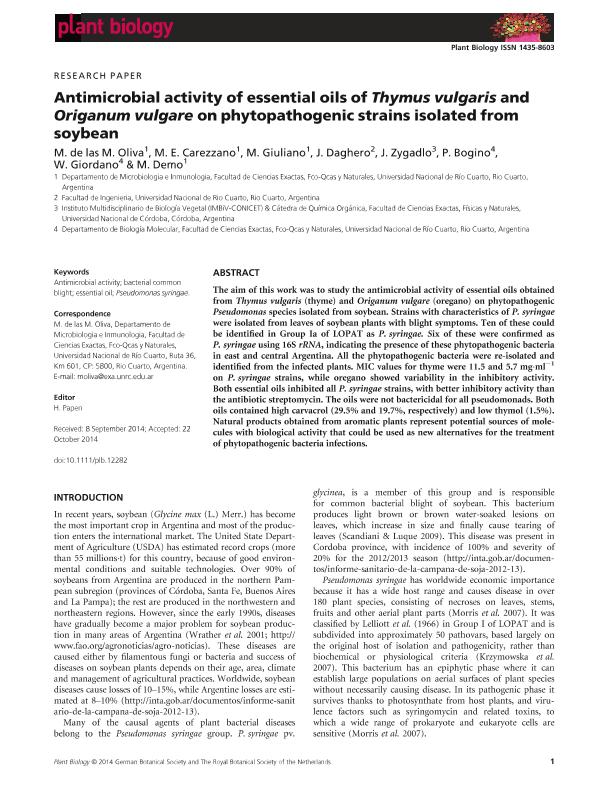Artículo
Antimicrobial activity of essential oils of Thymus vulgaris and Oreganum vulgare on phytopathogenic strains isolated from soybean
Oliva, Maria de Las Mercedes ; Carezzano, Maria Evangelina
; Carezzano, Maria Evangelina ; Giuliano, M.; Daghero, Jorge; Zygadlo, Julio Alberto
; Giuliano, M.; Daghero, Jorge; Zygadlo, Julio Alberto ; Bogino, Pablo Cesar
; Bogino, Pablo Cesar ; Giordano, Walter Fabian
; Giordano, Walter Fabian ; Demo, M.
; Demo, M.
 ; Carezzano, Maria Evangelina
; Carezzano, Maria Evangelina ; Giuliano, M.; Daghero, Jorge; Zygadlo, Julio Alberto
; Giuliano, M.; Daghero, Jorge; Zygadlo, Julio Alberto ; Bogino, Pablo Cesar
; Bogino, Pablo Cesar ; Giordano, Walter Fabian
; Giordano, Walter Fabian ; Demo, M.
; Demo, M.
Fecha de publicación:
10/2014
Editorial:
Wiley Blackwell Publishing, Inc
Revista:
Plant Biology
ISSN:
1435-8603
e-ISSN:
1438-8677
Idioma:
Inglés
Tipo de recurso:
Artículo publicado
Clasificación temática:
Resumen
The aim of this work was to study the antimicrobial activity of essential oils obtained from Thymus vulgaris (thyme) and Origanum vulgare (oregano) on phytopathogenic Pseudomonas species isolated from soybean. Strains with characteristics of P. syringae were isolated from leaves of soybean plants with blight symptoms. Ten of these could be identified in Group Ia of LOPAT as P. syringae. Six of these were confirmed as P. syringae using 16S rRNA, indicating the presence of these phytopathogenic bacteria in east and central Argentina. All the phytopathogenic bacteria were re-isolated and identified from the infected plants. MIC values for thyme were 11.5 and 5.7 mgml 1 on P. syringae strains, while oregano showed variability in the inhibitory activity. Both essential oils inhibited all P. syringae strains, with better inhibitory activity than the antibiotic streptomycin. The oils were not bactericidal for all pseudomonads. Both oils contained high carvacrol (29.5% and 19.7%, respectively) and low thymol (1.5%). Natural products obtained from aromatic plants represent potential sources of molecules with biological activity that could be used as new alternatives for the treatment of phytopathogenic bacteria infections.
Archivos asociados
Licencia
Identificadores
Colecciones
Articulos(IMBIV)
Articulos de INST.MULTIDISCIPL.DE BIOLOGIA VEGETAL (P)
Articulos de INST.MULTIDISCIPL.DE BIOLOGIA VEGETAL (P)
Citación
Oliva, Maria de Las Mercedes; Carezzano, Maria Evangelina; Giuliano, M.; Daghero, Jorge; Zygadlo, Julio Alberto; et al.; Antimicrobial activity of essential oils of Thymus vulgaris and Oreganum vulgare on phytopathogenic strains isolated from soybean; Wiley Blackwell Publishing, Inc; Plant Biology; 17; 10-2014; 758-765
Compartir
Altmétricas



